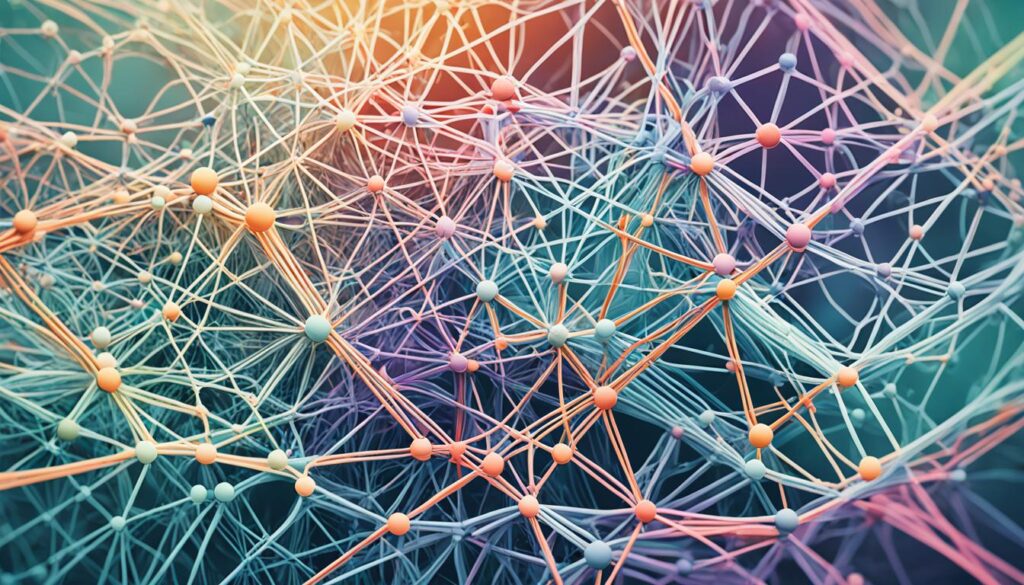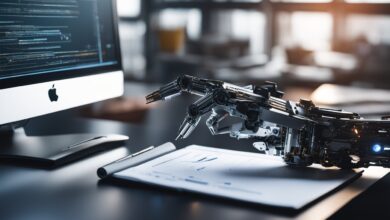What is Artificial Intelligence (AI)? A Beginner’s Guide

Artificial Intelligence (AI) is a fast-growing field that has caught the world’s attention. It’s changing our lives by making industries more efficient, automating tasks, and improving human skills. This guide will introduce you to AI basics, its history, and how it’s used today.
AI makes machines think like humans by learning, reasoning, and solving problems. It uses advanced algorithms and data to handle tough tasks, make smart choices, and act like us. AI is making a big impact in many areas, from helping with daily tasks to driving cars on their own. Its true potential is still being discovered.
Key Takeaways
- Artificial Intelligence (AI) is the simulation of human intelligence processes by machines, enabling them to learn, reason, and solve problems.
- AI has a rich history, with early developments in the 1950s and rapid advancements in recent years due to increased computing power and data availability.
- AI can be categorized into narrow (or weak) AI, general AI, and super AI, each with its own unique capabilities and applications.
- The core components of AI include machine learning, neural networks, and deep learning, which form the foundation for its transformative potential.
- AI is being applied in a wide range of industries, from healthcare and finance to transportation and entertainment, revolutionizing how we live and work.
This guide will help you understand AI basics. It’s perfect for anyone curious about technology, business leaders, or tech fans. It gives you a strong start to explore AI’s exciting future.
Understanding the Fundamentals of Artificial Intelligence
Artificial intelligence (AI) has been a topic of fascination and innovation for decades. It has driven advancements across various industries. Knowing the definition, history, and types of AI is key to understanding this fast-changing field.
AI Definition and Historical Overview
AI means using machines to act like human intelligence. This lets them do tasks that usually need human thought. The idea started in the 1950s with pioneers like Alan Turing, John McCarthy, and Marvin Minsky. They wanted to make intelligent machines.
Since then, AI has grown a lot. We’ve seen big leaps in machine learning, natural language processing, and computer vision.
Types of AI: Narrow, General, and Super AI
There are three main types of AI: narrow, general, and super. Narrow AI is for specific tasks, like playing chess or diagnosing diseases. General AI is a dream AI that can do as well as or better than humans in many areas. Super AI is the most advanced, meaning it’s smarter than humans in everything.
| AI Type | Description | Examples |
|---|---|---|
| Narrow AI | AI systems designed for specific tasks | Chess-playing algorithms, virtual assistants, image recognition |
| General AI | AI systems that can match or exceed human intelligence across a wide range of cognitive abilities | Hypothetical, not yet achieved |
| Super AI | AI systems that surpass human intelligence in all aspects | Hypothetical, not yet achieved |
Knowing these basic ideas about AI helps us understand this changing technology.
The Core Components of Artificial Intelligence
At the heart of Artificial Intelligence (AI) are two key parts: machine learning and neural networks. These technologies have changed AI, letting systems learn, adapt, and solve hard problems efficiently.
Machine Learning: The Foundation of AI
Machine learning is the base of AI. It lets systems learn from data and make smart choices without needing to be programmed. By looking at lots of information, these algorithms spot patterns, see trends, and predict what might happen. This helps AI tools and technologies get better and adapt, leading to new advances in AI in data science, AI learning models, and AI for problem-solving.
Neural Networks and Deep Learning
Neural networks and deep learning build on machine learning. They work like the human brain. These AI algorithms can handle complex, messy data, making big leaps in areas like natural language processing, computer vision, and decision-making. The growth in neural networks and deep learning is opening new doors in AI in automation and AI in everyday life.

By combining machine learning and neural networks, AI systems are getting smarter. This lets them do amazing things in many areas. As AI’s core parts keep getting better, the chances for AI in business and AI for problem-solving are huge.
What is Artificial Intelligence (AI)? Applications and Use Cases
Artificial Intelligence (AI) is changing how we live and work. It’s used in many areas, from healthcare to finance, education to transportation. AI is making a big difference in these fields.
AI in Healthcare
In healthcare, AI helps doctors with better tools for diagnosing and treating patients. It looks through lots of medical data to spot diseases early and help find new medicines. AI chatbots also give patients help and info any time they need it.
AI in Finance
AI is making finance smarter by helping with big decisions, catching fraud, and managing money better. It looks at financial data to find good investments and do boring tasks automatically. This helps people and companies make more money.
AI in Education
AI is changing education for the better. It creates learning plans that fit each student’s needs, making learning more effective. AI also helps students get help whenever they need it.
AI in Transportation
Transportation is changing thanks to AI. Self-driving cars use AI to make roads safer and smoother. AI also helps manage traffic, cutting down on delays and making roads better for everyone.
These examples show how AI is used in many areas. As AI gets better, it will touch more parts of our lives, making things better in big ways.
| Industry | AI Applications | Key Benefits |
|---|---|---|
| Healthcare | Diagnostic tools Personalized treatment Predictive analytics AI-powered chatbots | Early disease detection Improved patient outcomes Streamlined healthcare delivery 24/7 patient support |
| Finance | Automated decision-making Fraud detection Portfolio optimization | Enhanced financial performance Reduced financial risks Increased efficiency |
| Education | Personalized learning Adaptive teaching methods AI-driven virtual assistants | Improved learning outcomes Tailored educational experiences Enhanced student support |
| Transportation | Autonomous vehicles Intelligent traffic management | Increased safety Reduced congestion Optimized transportation infrastructure |
“Artificial Intelligence is not just a tool, but a transformative technology that is shaping the future of every industry and aspect of our daily lives.”
As AI becomes more common, we’re seeing new chances for growth and change. Using AI, we can make our lives, work, and interactions better in many ways.
The Future of Artificial Intelligence: Trends and Challenges
The world of Artificial Intelligence (AI) is always changing, bringing new trends and chances. But, it also faces big challenges. The future of AI could change many industries and daily life. It could also change how humans and machines work together.
AI Ethics and Responsible Development
Creating ethical AI is key to the AI future. As AI gets smarter and makes more decisions, we must use it right. We need to tackle AI ethics, bias, and make sure it’s clear and fair. This will help people trust AI and make sure it helps everyone.
AI in Business and Everyday Life
AI is changing how businesses work and our daily lives. It can make things more efficient and give us better experiences. But, using AI tools and understanding the AI ecosystem are tricky. We need to think carefully to get the most out of this new tech.
The AI industry is growing fast, bringing new AI breakthroughs and innovations. These could change how we think about intelligence. But, we need good AI programming and to think about the right use of this tech.

Conclusion
This guide has taken us on a journey through Artificial Intelligence (AI). We’ve looked at its history, what makes it work, and how it’s used today. It’s given a clear ai overview for those wanting to understand its big impact.
As ai becomes more important, it’s key for everyone to keep up. This article has shared lots of ai resources and ai education tips. It helps readers learn more about understanding ai and its future effects.
If you’re new to ai for non-techies or an ai professional looking to grow your knowledge, this guide is a great start. It covers the basics and key concepts of ai. With these insights and ai tutorials, you can start to use Artificial Intelligence to shape its future.
FAQ
What is Artificial Intelligence (AI)?
Artificial Intelligence (AI) is a branch of computer science. It aims to create systems that can do tasks that need human smarts, like learning and making decisions.
What are the different types of AI?
There are three main types of AI: Narrow AI, General AI, and Super AI. Narrow AI does specific tasks. General AI can handle many cognitive tasks. Super AI is when AI systems are smarter than humans in all areas.
What is the role of machine learning in AI?
Machine learning is key to AI. It lets systems learn from data and get better over time without needing to be told how. Machine learning helps AI models predict, recognize patterns, and make decisions on their own.
How do neural networks and deep learning contribute to AI?
Neural networks, like the human brain, are central to deep learning, a part of machine learning. Deep learning uses neural networks to spot complex patterns in data. This lets AI systems do tasks like seeing, understanding language, and recognizing speech.
What are some practical applications of AI?
AI is used in many areas, like healthcare (diagnosing diseases, finding new drugs), finance (spotting fraud, improving investments), education (personalized learning, grading), and transportation (self-driving cars, traffic management). It also helps in daily life, like with digital assistants and predicting what you might like.
What are the ethical considerations and challenges associated with AI?
As AI gets more advanced, concerns grow about bias, privacy, and how it affects jobs. It’s important to develop and use AI responsibly to make sure it helps society.
What is the future of AI, and what are the key trends to watch?
The future of AI looks bright, with more progress in understanding language, seeing the world, and making robots smarter. We’ll see more general AI, AI in businesses, and a focus on ethical AI to tackle its big challenges.



